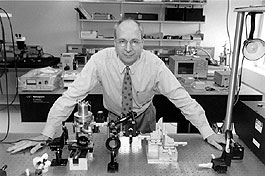 |
|
||
|
Vol. IV No. 3 · Week of 11 August 2000 |
|||
B.U. Bridge is published by the Boston University Office of University Relations.
Bright
idea
ENG
prof's invention could leave light bulbs in the dark ages
By Eric McHenry
On June 25, security personnel in the Orlando airport made E. Fred Schubert open his bag so they could inspect a suspicious-looking object. Schubert was transporting a heavy, pointed piece of glass, and the officer working the X-ray machine had never seen anything like it on the monitor.
|
|
|
|
E. Fred Schubert |
|
That's not surprising. Discover Awards for Technological Innovation are extraordinarily hard to come by. In winning the 11th annual competition's energy category, Schubert, ENG professor of electrical and computer engineering and a member of the Photonics Center faculty, survived a selection process in which thousands of worthy entries fell by the wayside. A "Super-Iron" battery that's both more environmentally friendly and more efficient by half than its conventional counterpart was good enough for second place. It was Schubert's photon recycling semiconduc- tor light-emitting diode (PRS-LED), a potentially revolutionary source of ambient white light, that earned the glass statuette, as well as a trip to Walt Disney World's EPCOT Center to claim it and a feature in the July issue of Discover magazine.
The author of that feature predicts nothing less than obsolescence for the traditional light bulb as a result of Schubert's invention. "Goodbye and thank you, Thomas Edison," he writes, calling Schubert "the new wizard on the block."
With 27 individual or jointly held patents to his name, Schubert certainly is something of a wizard. But he also knows enough about inventing to know never to talk down to Thomas Edison.
"I might have worded that in a different way," he says. "I know Thomas Edison's story quite well, and I have a great deal of respect for him. He kept his bed in his laboratory, because all he did was work and sleep. He was an unbelievably creative person.
"On the other hand," Schubert says, "I believe in novel technology. I believe that novel technology will continue to change our world, and that things we're used to today will be obsolete tomorrow. And the incandescent light bulb just doesn't fit into our world anymore, because it emits at the wrong wavelength. It's been useful for a long, long time. But it will go out the window really quickly if we have something better to replace it."
Schubert's LED seems like a strong candidate for the title "something better." It is many times as efficient and many times as long-lasting as Edison's bulb, which heats a filament in order to generate light and wastes considerable energy in the process.
"Most of the light from a conventional light bulb is emitted in the infrared region, where we can't see it," says Schubert. "Our eyes are not sensitive at a wavelength of one micron, which is the peak wavelength of the incandescent bulb. And that's awful. It's very inefficient."
Developed by Schubert and graduate students Xiaoyun (Jane) Guo (ENG'01) and John Graff (ENG'01), the PRS-LED uses a relatively new chemical compound called gallium indium nitride (GaInN). When excited by an electrical current, GaInN produces light in the blue-green range with almost no wasted energy. Schubert and his colleagues discovered that by redirecting the blue-green light through a layer of aluminum gallium indium phosphide (AlGaInP), which by itself yields light in the red-yellow range, they could create what the eye experiences as ambient white light.
The theoretical efficiency of this dichromatic light source is more than 10 times that of the bulb, Schubert says. And because GaInN is very stable, a single LED could function for as many as 50 years.
Although the LED's commercial success will depend upon the number of contexts in which it is deemed valuable, he says, its widespread use could reduce national energy consumption by 10 percent.
"That calculation," Schubert adds, "assumes that light consumption remains constant. There is the human factor to think about. People might say, 'Oh, light is now cheaper. Let's leave the light on overnight.'
"But I think technology is helping people be more responsible," he says. "For example, in this building [the Photonics Center], the lights are switched off automatically. So I think the potential for savings is very real."
Having caught wind of the discovery, various companies are already at the door of the Photonics Center, Schubert says. He has met with representatives of Agilent Technologies and Delphi Automotive Systems to discuss the invention's potential appliations, and hopes one or more PRS-LED-based light sources will be on the market within five years.
"It's my greatest hope," he says, "and we're working, through the Photonics Center, to bring commercialization of this LED into a well-defined framework. It's so satisfying to see devices that we invent here at BU being manufactured by commercial partners."
![]()
14
August 2000
Boston University
Office of University Relations
